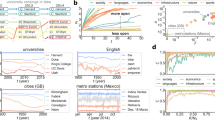Abstract
Ranking procedures are widely used in the description of many different types of complex systems. Zipf's law is one of the most remarkable frequency-rank relationships and has been observed independently in physics, linguistics, biology, demography, etc. We show that ranking plays a crucial role in making it possible to detect empirical relationships in systems that exist in one realization only, even when the statistical ensemble to which the systems belong has a very broad probability distribution. Analytical results and numerical simulations are presented which clarify the relations between the probability distributions and the behavior of expected values for unranked and ranked random variables. This analysis is performed, in particular, for the evolutionary model presented in our previous papers which leads to Zipf's law and reveals the underlying mechanism of this phenomenon in terms of a system with interdependent and interacting components as opposed to the “ideal gas” models suggested by previous researchers. The ranking procedure applied to this model leads to a new, unexpected phenomenon: a characteristic “staircase” behavior of the mean values of the ranked variables (ranked occupation numbers). This result is due to the broadness of the probability distributions for the occupation numbers and does not follow from the “ideal gas” model. Thus, it provides an opportunity, by comparison with empirical data, to obtain evidence as to which model relates to reality.
Similar content being viewed by others
References
Auerbach, F. (1913). Das Gesetz der Bevölkerungskonzentration [The law of population concentration],Petermans Mitteilungen,59, 74.
Borodovsky, M. Yu., and Gusein-Zade, S. M. (1989). A general rule for ranked series of codon frequencies in different genomes.Journal of Biomolecular Structure and Dynamics,6, 1001.
Brokes, B. C. (1982). Qualitative analysis in the humanities: The advantage of ranking techniques, inStudies on Zipf's Law, H. Guiter and M. V. Arapov, eds., Studienverlag Dr. N. Brockmeyer, Bochum, Germany.
Frankhauser, P. (1991). The Pareto-Zipf-distribution of urban systems as stochastic process, inModels of Selforganization in Complex Systems, W. Ebeling, M. Peschel, and W. Weidlich, eds., Akademie Verlag, Berlin.
H. Guiter and M. V. Arapov, eds. (1982).Studies on Zipf's Law, Studienverlag Dr. N. Brockmeyer, Bochum, Germany.
Günther, R., and Wagner, P. (1995). Analysis of real texts, NRI Internal Report.
Günther, R., Schapiro, B., and Wagner, P. (1992). Physical complexity and Zipf's law,International Journal of Theoretical Physics,31, 525–543.
Günther, R., Schapiro, B., and Wagner, P. (1993). Critical specific complexity: Recent results, NMI Internal Report.
Katsikas, A. A., and Nicolis, J. S. (1990). Chaotic dynamics of generating Markov partitions and linguistic sequences mimicking Zipf's law,Nuovo Cimento,12D, 177.
Kohonen, T. (1982). Analysis of a simple self-organizing process,Biological Cybernetics,44, 135–140.
Levitin, L. B., and Schapiro, B. (1993). Zipf's law and information complexity in an evolutionary system, inProceedings IEEE International Symposium on Information Theory, San Antonio, Texas, p. 76.
Li, W. (1992). Random texts exhibit Zipf's-law-like word frequency distributions,IEEE Transactions on Information Theory,38, 1842.
Mandelbrot, B. B. (1953). An information theory of the statistical structure of language, inCommunication Theory, W. Jackson, ed., London, pp. 486–502.
Mandelbrot, B. B. (1983).The Fractal Geometry of Nature, Freeman, New York.
Nicolis, J. S., and Tsuda, I. (1989). On the parallel between Zipf's law and 1/f process in chaotic systems possessing coexisting attractors,Progress of Theoretical Physics,82, 254–274.
Orlov, J. K. (1982). Ein Modell der Häufigkeitsstruktur des Vokabulars, inStudies on Zipf's Law, H. Guiter and M. V. Arapov, eds., Studienverlag Dr. N. Brockmeyer, Bochum, Germany.
Pareto, V. (1897).Cour d'Economie Politique, Lausanne and Paris [reprinted inOevre Completes, Genf Droz].
Schapiro, B. (1994). An approach to the physics of complexity,Chaos, Solitons and Fractals,4, 115–123.
Sharman, R. A. (1989). Observational evidence for a statistical model of language, IBM UKSC Report 205, September 1989.
Shreider, Yu. A. (1967). Theoretical derivation of text statistical features,Problemy Peredachi Informatsii,3, 57–63.
Willis, J. C. (1922).Age and Area, Cambridge University Press, Cambridge.
Zipf, G. K. (1935).The Psychobiology of Language, Houghton-Miflin, Boston.
Zipf, G. K. (1949).Human Behavior and the Principle of Least Effort, Addison-Wesley, Cambridge, Massachusetts.
Author information
Authors and Affiliations
Rights and permissions
About this article
Cite this article
Günther, R., Levitin, L., Schapiro, B. et al. Zipf 's law and the effect of ranking on probability distributions. Int J Theor Phys 35, 395–417 (1996). https://doi.org/10.1007/BF02083823
Received:
Issue Date:
DOI: https://doi.org/10.1007/BF02083823




